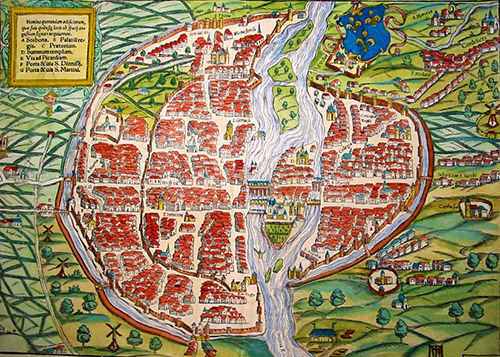Paris has changed a lot over the past 10 millennia: the earliest evidence of human habitation dates back to around 9,800 years ago, when Mesolithic hunter-gatherers made their home in what is now the 15th arrondissement.
Excavations at Bercy turned up fragments of three wooden canoes, dating from between 4,800-4,500BC, and iron age hatchets from eastern Europe, suggesting that these early Parisians had already established trade relations with other areas of Europe.
In what is now rue Henri-Farman, archaeologists have discovered settlement artefacts, such as ceramics, fragments of animal bones, and parts of polished axes, from the middle Neolithic, the early bronze, and iron ages.
During the 3rd century BC, the Celtic Parisii settled on the banks of the Seine and what is now the Île de la Cité, and built a walled settlement (oppidum) there, along with toll bridges across the river. According to the Roman geographer, Ptolemy, this settlement was called Leucotecia, and it’s believed to have taken its name from the Celtic word for marsh, luco. The traders of Leucotecia prospered, and coins from the city-settlement have been excavated from sites in Germany and Spain.
After the Battle of Lutetia in 52BC, which took place close to where the Eiffel Tower now stands, the Romans built a new city, which they named Lutetia Parisiorum (Marsh of the Parisii).
In 275AD, the Alamans were the first of the Germanic tribes to invade the Western Roman Empire (hence Allemagne being French for Germany). The citizens of Lutetia fled the Left Bank for the safety of the island, and built Paris’ first city wall. They also built new baths and a new basilica in what is now the square in front of Notre Dame.  Thirty years later, the city changed its name to Civitas Parisiorum – City of the Parisii, and by the end of the Empire, it was known simply as Parisius.
Over the next two centuries, more Germanic invasions ensued, sending Paris, and the Western Roman Empire in general, into decline. In 451 AD, the most famous Germanic leader, Attila the Hun, threatened the city; however, instead of abandoning their homes, the Parisians held fast, and Attila attacked Orléans instead.
In 461, Childeric I, the king of the Salian Franks from the Rhine delta, laid siege to the city. The siege lasted for 10 years, before Paris finally yielded to Childeric.
In 481, Childeric’s 15 year old son, Hlodwig – better known as Clovis I (from where we get the name, Louis) – became the new Frankish king, defeating the last of the Roman armies just four years later, in 486. By this time, various Germanic tribes had already conquered most of Gaul but Clovis united the country, becoming the first Merovingian ruler, and making Parisius his capital.
Four centuries later, in 843, the French state, Francia – named after the Franks – was founded after it broke away from the Carolingian Empire. It is now one of the oldest states in Europe.
